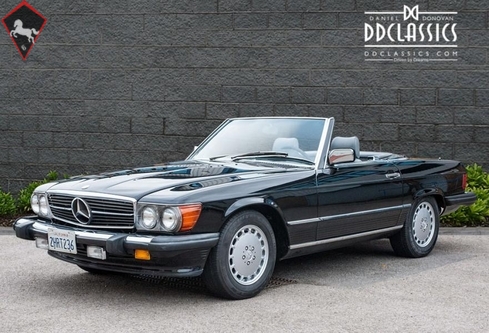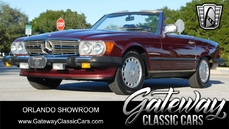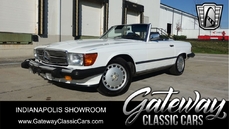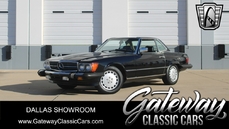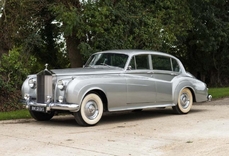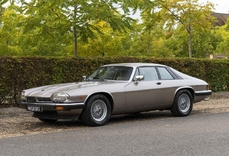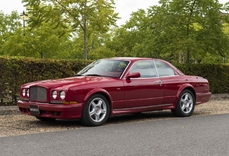Mercedes-Benz 560SL w107 (LHD) 1988
General description :
1988 Mercedes-Benz 560SL (LHD) – For sale in London
72,202 Miles from new
Alpaca Grey Leather interior
Matching Black hard & soft top
Original Becker ‘Mexico Grand Prix’ radio
No formal introduction is needed to the iconic R107, but when Mercedes-Benz took the W114/W115 chassis and the engines from the W126 S-Class range, the ‘Sports Line’ range was born and production began in 1971. Success spread across the globe for 18 years of production, however in North America only the 450SL (with a low compression 4.5 litre V8 engine) was supplied up till 1980, when the lesser powerful replacement 380SL came into production under restrictions of emission laws.
Fast forward to 1986 and finally the more powerful 560 engine was made available from the factory to go into the SL range. Exclusive to the USA, Japanese and Australian markets, the 560SL ticked every box, ensuring an iconic place in the Mercedes-Benz brand lineup.
Our 560SL is an original US-spec model, which had its pre-delivery inspection on 21st November 1987 and given its history file, has spent the majority of its life in the State of California, allowing it to be free from corrosion. Complete as it left the factory, it’s finished in stunning Gloss Black (Paint code 040) with its colour matching hard top and black fabric soft top in beautiful condition.
The interior is in outstanding condition with no scarring to the Alpaca Grey Leather seats and the steering wheel has little wear. Sitting centrally is the original Becker ‘Mexico Grand Prix’ radio and other comforts such as automatic climate control.
As you would expect from the 560 V8, performance on the road is seamlessly delivered and the 4-speed automatic gearbox goes up and down through the gears without fault.
This 560SL is in beautiful condition and with just 72,202 miles on the odometer it is apparent it has been extremely well cared for, and has resided in dryer climates, making it an attractive car for its next owner.
Options:
240 OUTSIDE TEMPERATURE INDICATOR
262 ELIMINATION OF REAR END SPOILER
442 AIRBAG IN STEERING WHEEL
461 INSTRUMENT WITH MILES IND. AND ENGLISH LEGEND
494 VERSION FOR USA
506 OUTSIDE REAR VIEW MIRROR, LEFT AND RIGHT, HEATED (ELECTRICALLY ADJUSTABLE ON THE RIGHT)
519 BECKER RADIO MEXICO GRAND PRIX, ELECTRONIC
524 PAINTWORK – PRESERVATION
531 AUTOMATIC ANTENNA
543 SUN VISOR WITH VANITY MIRROR, ILLUMINATED, LEFT AND RIGHT
551 ANTI-THEFT/ANTI-BREAK-IN WARNING SYSTEM
570 FOLDING ARMREST, FRONT
581 AUTOMATIC CLIMATE CONTROL
592 HEAT-INSULATING GLASS, ALL-AROUND, HEATED REAR WINDOW PANE, BAND FILTER
639 ELIMINATION OF FIRST-AID BOX AND WARNING TRIANGLE
740 BLACK SOFT TOP FABRIC 9001
808 AEJ 06/1/M/X
This truly exceptional 560 SL is now available for viewing at the DD Classics Dealership in London, please call to book an appointment.
http://ddclassics.com/car-listing/mercedes-benz-560sl-lhd/
1988 Mercedes-Benz 560SL w107 (LHD) is listed sold on ClassicDigest in Surrey by DD Classics for Not priced.
Car Facts
Car type : Car Make : Mercedes-Benz Model : 560SL w107 Model Version : (LHD) Engine size : 99.9 Model Year : 1988 Sub type : Station wagon Location : Surrey
Sold
Seller Information
Sold
People who viewed this Mercedes-Benz 560SL w107 also viewed similar Mercedes-Benz listed at ClassicDigest
Other cars listed for sale by this dealer
About Mercedes-Benz
In the annals of automotive history, the journey of Mercedes-Benz is a tale that unfolds with the ingenuity of its founding pioneers. In the year 1886, Karl Benz crafted the Benz Patent Motorwagen, a creation that would go down in history as the world's inaugural automobile. Unbeknownst to him, this moment marked the genesis of what would evolve into the most illustrious premium car manufacturer globally. The financial underpinning of this pioneering venture, interestingly, was provided by Karl Benz's wife, Bertha Benz, demonstrating a remarkable partnership that would set the tone for Mercedes-Benz's legacy.A parallel narrative emerged not far away, as Daimler-Motoren-Gesellschaft, founded by Gottlieb Daimler and Wilhelm Maybach, entered the scene. In 1901, they unveiled their automobile under the now-famous moniker "Mercedes," meaning "godsend" in Spanish. This name was bestowed upon the car at the behest of Emil Jellinek's daughter, the distributor for Daimler-Motoren-Gesellschaft. The wheels of innovation were set in motion.
Fast forward to 1926, a pivotal year that witnessed the merger of Daimler with Benz & Cie., culminating in the birth of Daimler-Benz. The amalgamation saw the adoption of "Mercedes-Benz" as the distinguished trademark for their automobiles, fusing the legacies of two visionary entities into one.
Contrary to perceptions of conservatism, the trajectory of Daimler-Benz unfolds as a chronicle of industry firsts. From the introduction of the honeycomb radiator to the float carburetor, and the pioneering implementation of four-wheel brakes in 1924, Daimler-Benz consistently pushed the boundaries of automotive innovation. The diesel-powered Mercedes-Benz 260 D in 1936 marked the inception of diesel engines in passenger cars. The iconic Mercedes-Benz 300SL Gullwing made history as the first car with direct fuel injection, albeit the Gutbrod's tiny 2-stroke engine can claim precedence.
Safety innovations became a hallmark, with Béla Barényi's patented safety cell design in the "Ponton"-models in 1951, featuring front and rear crumple zones. The W116 450SEL 6.9 saw the introduction of the Anti-Lock Brake system (ABS), another pioneering safety feature. From the first production airbags and beyond, the legacy of "firsts" continued to be etched into the fabric of Daimler-Benz.
Over its centennial journey, Mercedes-Benz has not merely produced cars but has sculpted automotive icons. The SSKL, 710 SSK Trossi Roadster, 770K Grosser, 540K Spezial Roadster, 300SL Gullwing, w100 600 Pullman, w111 280SE 3.5 Flachkühler, w113 230SL Pagoda, w109 300 SEL 6.3, and w201 2.3-16 Cosworth stand testament to the brand's commitment to engineering excellence.
The roaring Silver Arrows, or "Silberpfeile," including the W 25, W 125, W154, W165, and W196, created a legacy of dominance on the racetrack. These machines were not merely cars; they were expressions of precision, speed, and an indomitable spirit that left their competitors in the dust.
As Mercedes-Benz marches into the future, it does so not just as an automaker but as a custodian of a legacy, a torchbearer of innovation, and a beacon of automotive excellence. The road ahead is sure to witness the continued fusion of cutting-edge technology, timeless design, and an unwavering commitment to setting new standards in the world of automobiles.
One luminary figure who left an indelible mark was Béla Barényi, often heralded as the "father of passive safety" for his pioneering work in safety engineering. His patented safety cell design, featuring front and rear crumple zones, became a hallmark of Mercedes-Benz's commitment to occupant safety, setting new standards that reverberated throughout the automotive world.
Moving through the chronicles, the collaborative genius of Wilhelm Maybach, alongside Gottlieb Daimler, laid the foundation for Daimler-Motoren-Gesellschaft. Their innovations not only birthed the first Mercedes but established a culture of relentless pursuit of technological excellence that remains integral to Mercedes-Benz's DNA.
In the post-merger era of 1926, Ferdinand Porsche emerged as a prominent figure within Mercedes-Benz. His work on the Mercedes-Benz S-Type, a supercharged race car, garnered acclaim and set the stage for a legacy that extended far beyond the marque. Porsche's impact would later extend to his eponymous company, but his influence at Mercedes-Benz during those formative years was pivotal.
As the 20th century progressed, the legendary Rudolf Uhlenhaut emerged as a key figure. Uhlenhaut, an accomplished engineer and the driving force behind the iconic Silver Arrows, played a crucial role in Mercedes-Benz's dominance in motorsports. His engineering prowess and attention to detail were instrumental in creating some of the most formidable racing cars of the era.
In the latter half of the century, figures like Bruno Sacco, the head of design at Mercedes-Benz from 1975 to 1999, left an indelible imprint on the brand's aesthetic identity. Sacco's design philosophy, characterized by clean lines and timeless elegance, shaped iconic models like the W126 S-Class and the W201 190E, solidifying Mercedes-Benz's reputation for luxury and sophistication.
The narrative would be incomplete without acknowledging the contributions of engineers like Hans Scherenberg, whose leadership in the 1970s ushered in a new era of technological innovation at Mercedes-Benz. Scherenberg's tenure saw the development of groundbreaking technologies, including the Anti-Lock Brake system (ABS) and the introduction of airbags in production cars.
